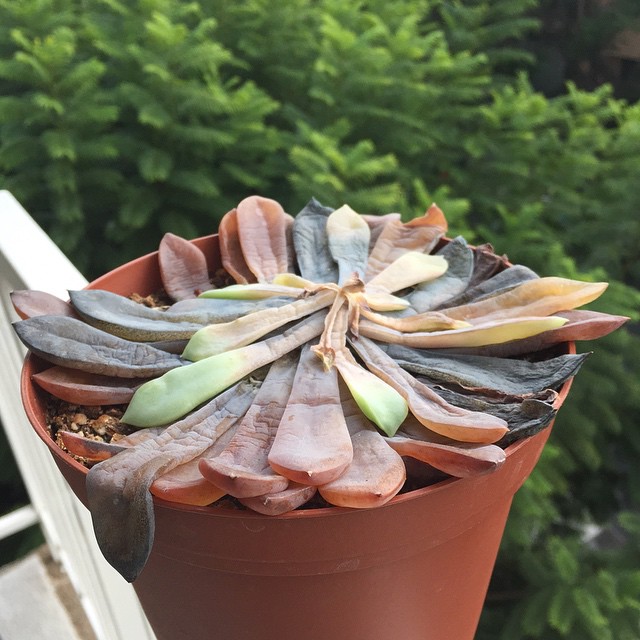To fix an overwatered succulent, remove it from the soil, let it dry out, and replant in well-draining soil. Overwatering can cause root rot, killing the plant.
Succulents thrive in dry conditions, so allowing the soil to dry out completely between watering is important. Additionally, make sure the pot has proper drainage to prevent water from accumulating at the roots. Providing adequate sunlight and avoiding excessive fertilization can also help revive an overwatered succulent.
Avoiding overwatering in the future is crucial for the plant’s health and longevity.

Signs Of Overwatering
Overwatering can cause several signs in succulents. One common sign is yellowing or mushy leaves. This indicates that the plant is receiving too much moisture. Another sign is root rot, which can occur when the roots are continuously saturated with water.
Wilting, despite the soil being moist, is another indicator of overwatering. To fix an overwatered succulent, allow the soil to dry out completely before watering again. Ensure that the pot has proper drainage, and adjust the watering schedule according to the plant’s needs.
Remember, succulents are desert plants and prefer dry conditions. So, it’s essential to strike the right balance to keep your succulent healthy and thriving.
How to Fix Overwatered Succulent: Step by Step Guide
Evaluating The Damage
When fixing an overwatered succulent, the first step is to carefully remove the plant from its pot. Inspect the roots thoroughly, looking for any signs of rot or decay. This will help you evaluate the extent of the damage and determine the overall health of the plant.
By following these guidelines, you can save your overwatered succulent and restore it to its thriving state. Take the time to assess the damage and implement the necessary steps to revive your succulent. With proper care and attention, your plant will soon be back to its vibrant and healthy self.
Revive An Overwatered Succulent
To fix an overwatered succulent, the first step is to let it dry out completely. This process may take several days or even weeks, depending on the severity of the overwatering. Once the succulent is dry, carefully repot it in well-draining soil to prevent future waterlogging.
Make sure to choose a pot with drainage holes to allow excess water to escape. Adjust the watering schedule and amount to avoid overwatering again. Succulents prefer infrequent but deep watering, allowing the soil to dry out between waterings. Pay attention to the signs of underwatering or overwatering, such as shriveled leaves or rotting roots.
With proper care and attention, an overwatered succulent can be revived and thrive once again.
Preventing Overwatering In The Future
To prevent overwatering succulents in the future, it’s crucial to select the right pot and soil. Succulents require well-draining soil and pots with drainage holes to avoid excessive water retention. Understanding the specific watering needs of succulents is essential. These plants thrive in dry conditions, so it’s best to water them sparingly and allow the soil to dry out completely between waterings.
Creating a watering schedule can help establish a routine and prevent overwatering. By monitoring the moisture content in the soil and adjusting your watering frequency accordingly, you can ensure that your succulents stay healthy and avoid the risk of root rot caused by overwatering.
Remember, proper pot and soil selection, along with a consistent watering schedule, are key to maintaining optimal succulent growth and preventing overwatering issues.
Common Mistakes To Avoid
Overwatering succulents is a common mistake many people make due to misconceptions about these plants. One mistake to avoid is ignoring the signs of overwatering, such as mushy leaves or root rot. Another mistake is using improper soil or pots that do not allow for proper drainage.
When caring for succulents, it is essential to remember that they are desert plants and require less water compared to other houseplants. To fix overwatered succulents, allow the soil to dry out completely between waterings and ensure the pot has drainage holes to prevent water from accumulating.
By avoiding these common mistakes and providing the right conditions, you can help your succulents thrive and prevent issues caused by overwatering.
Frequently Asked Questions For How To Fix Overwatered Succulent
How Can I Revive An Overwatered Succulent?
To revive an overwatered succulent, remove it from the soil and allow it to dry out completely. Trim any rotted or mushy parts, then repot the succulent in fresh, well-draining soil. Gradually reintroduce watering, making sure the soil dries out between waterings.
How Often Should I Water My Succulent?
Succulents generally don’t require much water. Water them thoroughly but infrequently, allowing the soil to dry out completely between waterings. The frequency of watering will depend on factors such as the type of succulent, the climate, and the size of the pot.
How Can I Prevent Overwatering My Succulent?
To prevent overwatering, make sure to use a well-draining soil mix specifically formulated for succulents. Only water when the soil is completely dry, and ensure the succulent is in a pot with drainage holes. Pay attention to the signs of overwatering, such as yellowing leaves or mushy stems, and adjust your watering routine accordingly.
Conclusion
To summarize, overwatering is a common mistake when caring for succulents, but it’s not irreversible. By following the steps mentioned you can fix an overwatered succulent and restore it back to health. Firstly, assess the damage by checking for signs of overwatering such as yellowing leaves or a mushy stem.
Next, adjust the watering schedule by allowing the soil to dry out completely before watering again. Remember to use well-draining soil and pots with drainage holes to prevent future overwatering. Additionally, consider the humidity levels and temperature of your environment as these can affect watering needs.
Finally, pruning any damaged or dead parts of the succulent will promote growth and help it recover. By being vigilant in your watering habits and providing the right conditions, your succulents will thrive and bring beauty to your space.

